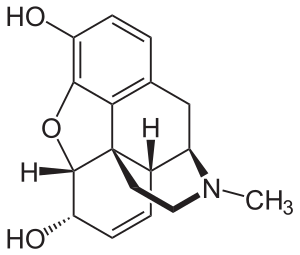Morphine
Information about Morphine
Morphine is one of the natural plant alkaloids found in opium and is the prototype opiate, against which other derivatives are measured in terms of analgesic effects and side effects.
Liver safety of Morphine
Morphine has not been linked to serum enzyme elevations during therapy or to clinically apparent liver injury.
Mechanism of action of Morphine
Morphine is a natural alkaloid that is derived from resin extracts from the seeds of the opium poppy, Papaver somniferum. Morphine has potent and profound analgesic effects and has been used in clinical medicine for almost two hundred years. Morphine acts by engagement in cell surface opiate receptors (predominant µ type receptors) that are found in the central nervous system, but also heart, lung, vascular and intestinal cells. Current indications are for severe pain, pre- and postoperative analgesia, control of pain from angina pectoris or acute myocardial infarction and therapy of pulmonary edema.
Dosage and administration for Morphine
Morphine is available in multiple formulations, including oral tablets and syrups, suppositories, and solutions for injection in multiple concentrations. The typical dose of morphine for analgesia in adults is 10 mg every 3 to 4 hours by the subcutaneous, intramuscular or intravenous route. Morphine is well absorbed orally, but has extensive and variable first pass metabolism, so that its effect orally is somewhat variable.
Side effects of Morphine
Side effects of opiates are many and include sedation, respiratory depression, confusion, euphoria, agitation, itching, abdominal bloating, nausea, vomiting and diarrhea.
DEA controlled substance classification of Morphine
Morphine is a controlled substance and classified as a Schedule II drug, indicating that it has medical usefulness, but also a high potential for physical and psychological dependency and abuse. Full and partial opiod agonists:
- Alfentanil
- Butorphanol
- Codeine
- Diphenoxylate
- Fentanyl
- Heroin
- Hydrocodone
- Hydromorphone
- Levorphanol
- Loperamide
- Meperidine
- Methadone
- Morphine
- Opium
- Oxycodone
- Oxymorphone
- Pentazocine
- Remifentanil
- Sufentanil
- Tramadol
Opiate antagonists:
Lua error in package.lua at line 80: module 'strict' not found. Lua error in package.lua at line 80: module 'strict' not found.
| Opioid receptor modulators | ||||||||||||||||||||||||||||||||
|---|---|---|---|---|---|---|---|---|---|---|---|---|---|---|---|---|---|---|---|---|---|---|---|---|---|---|---|---|---|---|---|---|
|
Lua error in package.lua at line 80: module 'strict' not found.
Transform your life with W8MD's budget GLP-1 injections from $125.
W8MD offers a medical weight loss program to lose weight in Philadelphia. Our physician-supervised medical weight loss provides:
- Most insurances accepted or discounted self-pay rates. We will obtain insurance prior authorizations if needed.
- Generic GLP1 weight loss injections from $125 for the starting dose.
- Also offer prescription weight loss medications including Phentermine, Qsymia, Diethylpropion, Contrave etc.
NYC weight loss doctor appointments
Start your NYC weight loss journey today at our NYC medical weight loss and Philadelphia medical weight loss clinics.
- Call 718-946-5500 to lose weight in NYC or for medical weight loss in Philadelphia 215-676-2334.
- Tags:NYC medical weight loss, Philadelphia lose weight Zepbound NYC, Budget GLP1 weight loss injections, Wegovy Philadelphia, Wegovy NYC, Philadelphia medical weight loss, Brookly weight loss and Wegovy NYC
|
WikiMD's Wellness Encyclopedia |
| Let Food Be Thy Medicine Medicine Thy Food - Hippocrates |
Medical Disclaimer: WikiMD is not a substitute for professional medical advice. The information on WikiMD is provided as an information resource only, may be incorrect, outdated or misleading, and is not to be used or relied on for any diagnostic or treatment purposes. Please consult your health care provider before making any healthcare decisions or for guidance about a specific medical condition. WikiMD expressly disclaims responsibility, and shall have no liability, for any damages, loss, injury, or liability whatsoever suffered as a result of your reliance on the information contained in this site. By visiting this site you agree to the foregoing terms and conditions, which may from time to time be changed or supplemented by WikiMD. If you do not agree to the foregoing terms and conditions, you should not enter or use this site. See full disclaimer.
Credits:Most images are courtesy of Wikimedia commons, and templates, categories Wikipedia, licensed under CC BY SA or similar.
- Pages with script errors
- Drugs
- Morphine
- Cyclohexenols
- Chemical substances for emergency medicine
- 4,5-Epoxymorphinans
- Ethers
- Euphoriants
- GABAA receptor negative allosteric modulators
- Glycine receptor antagonists
- Human metabolites
- Kappa-opioid receptor agonists
- Mu-opioid receptor agonists
- Natural opium alkaloids
- Opiates
- Phenols
- Plant toxins
- Secondary metabolites
Contributors: Prab R. Tumpati, MD

